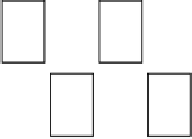Information Technology Reference
In-Depth Information
tire cube being active and the other not (warning, this
could take hundreds of tries, depending on how for-
tuitous your random seeds are). When this happens,
note the plot of the harmony value in the graph log. It
should be substantially below all the other traces that
correspond to a consistent solution on one cube. Thus,
an inconsistent partial satisfaction of the weight con-
straints has lower harmony than full satisfaction of the
constraints in one cube.
Noise added to the membrane potential is playing an
important role in this simulation — without it, there
is nothing to “break the tie” between the two cube in-
terpretations. To see this, let's manipulate the level of
noise.
Figure 3.29:
Necker cube network, with the group of units
on the left representing the vertices of the downwards look-
ing view (
b)
in previous figure), and the group on the right
representing the vertices of the upward-looking view (
c)
in
previous figure).
Try the following values of
noise_var
: 0, .1, .01,
.000001.
Question 3.16 (a)
Report what differences you ob-
served in the settling behavior of the network for these
different values.
(b)
What does this tell you about how
noise is affecting the process?
tations (the left cube corresponding to figure 3.28b, and
the right to figure 3.28c). All of the units are within
one layer, which has the basic kWTA inhibition oper-
ating with a
k
parameter of 8. Thus, only one of the
two cubes can be active at any given time under these
constraints. As usual, let's examine the weights. Notice
that each unit is connected to its local neighborhood of
vertices. Thus, when one vertex gets active, it will tend
to activate the others, leading to the activation of a con-
sistent interpretation of the entire cube. However, at the
same time, the other interpretation of the cube is also
activating its vertices, and, via the inhibition, compet-
ing to get active.
You might also try playing with different activation
functions by setting the
act_fun
parameter.
Finally, one of the important psychological aspects
of the Necker cube stimulus is that people tend to os-
cillate between the two possible interpretations. This
probably occurs because the neurons that are activated
for one interpretation get
tired
eventually, allowing the
other competing units to become active. This process of
neurons getting tired is called
accommodation
,andis
a well established property of neurons that was covered
in section 2.9.
Return to viewing
act
in the network. To view the
harmony, do
View
and select
GRAPH_LOG
. Then, press
Run
to view the competition process in action.
During running, both interpretations receive equal
but weak amounts of excitatory input. You should see
that as the network settles there is a point where some
units in both cubes are active, with some wavering of
strength back and forth until one cube eventually wins
out and is fully active while the other remains inactive.
Use the
accommodation
field to turn this property
on or off (
ACCOMMODATE
or
DONT_ACCOMMODATE
).
When it is on, the network runs for 500 cycles instead
of 60, and you should observe at least two oscillations
from one cube to the next as the neurons get tired.
To stop now, quit by selecting
Object/Quit
in the
PDP++Root
window.
3.7
Summary
Tr y
Run
ning many times.
You should note that which cube wins is random. If
you are persistent, you should eventually observe a case
where part of each cube is activated, instead of one en-
We now have a number of important principles of net-
work function at our disposal. These principles provide













Search WWH ::

Custom Search